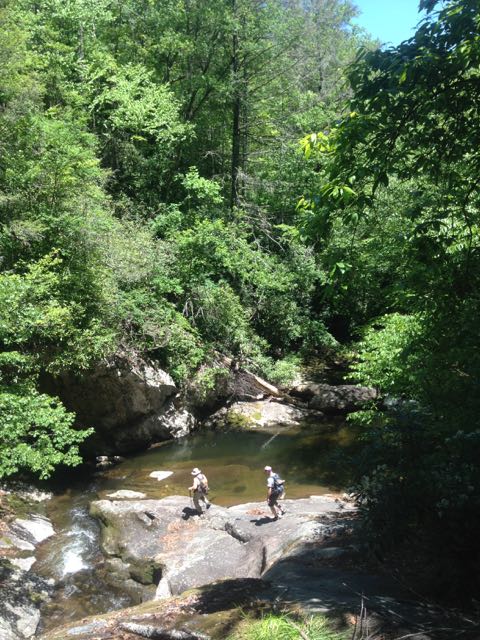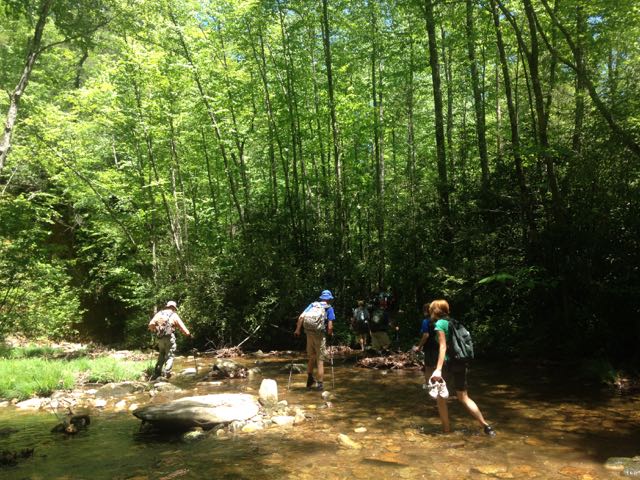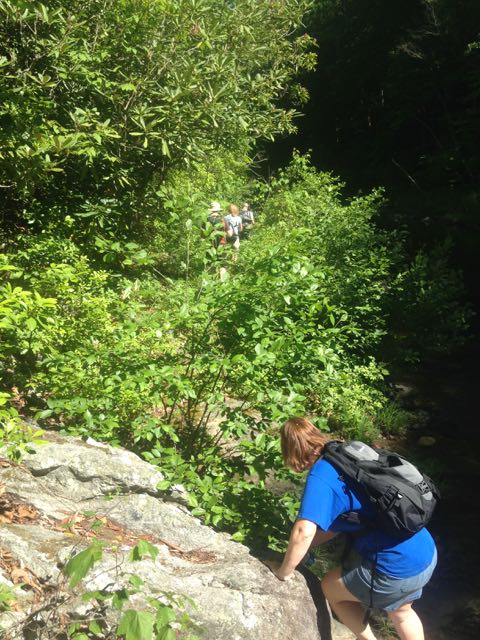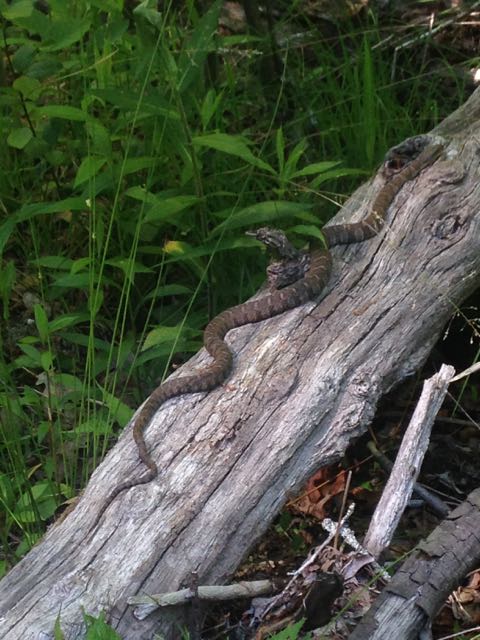 On the surface, the Black Mountains, Mackey Mountain and the Fires Creek Recreation Area appear slam-dunk candidates for wilderness designation. The Blacks, with a 13-mile-long ridgeline mostly above 6,000 feet, host the highest peaks on the East Coast, topped by a boreal forest more commonly found in Canada. Mackey Mountain in the shadow of Grandfather Mountain has the largest stand of old growth forest — nearly 6,000 acres — in the Pisgah National Forest. And the Fires Rim Area west of Franklin sequesters itself from outside influences via a horseshoe-shaped ridgeline that runs 25 miles.
On the surface, the Black Mountains, Mackey Mountain and the Fires Creek Recreation Area appear slam-dunk candidates for wilderness designation. The Blacks, with a 13-mile-long ridgeline mostly above 6,000 feet, host the highest peaks on the East Coast, topped by a boreal forest more commonly found in Canada. Mackey Mountain in the shadow of Grandfather Mountain has the largest stand of old growth forest — nearly 6,000 acres — in the Pisgah National Forest. And the Fires Rim Area west of Franklin sequesters itself from outside influences via a horseshoe-shaped ridgeline that runs 25 miles.
Together, they represent 88,000 acres that public-lands-advocate Wild South wants the U.S. Forest Service to nominate for wilderness designation as part of its current Forest Management Plan review for the Pisgah and Nantahala National Forests. The four-year process is currently in the public comment stage.
“Lost Cove and Harper Creek are two of the last remaining wild areas that have escaped the rapid development of North Carolina’s High Country,” according to Appalachian Voices, a Boone-based advocacy group dedicated to protecting the central and southern Appalachians. “They are national treasures in our own backyard.”
Even if the Forest Service adopts Wild South’s recommendation, even if those 88,000 acres are recommended to Congress for wilderness designation under the 1964 Wilderness Act, and even if there’s general agreement in Congress that the areas deserve protection, that doesn’t mean wilderness protection is imminent.
Just look at the Lost Cove/Harper Creek area, which has been in wilderness limbo for more than 30 years.
Lost Cove and Harper Creek: Seeing green
 In 1984, this nearly 13,000-acre expanse of rowdy, robust terrain at the base of Grandfather Mountain was deemed wilderness worthy. The area includes nearly 2,200 acres of old growth forest, black bears, peregrine falcons, wild trout streams, a cavalcade of cascades (many ending in classic swimming holes), rock formations more than 800 million years old and a who’s-who of Appalachian forest types. To hikers, the area is best known for the primitive trails that hopscotch Harper and North Harper creeks.
In 1984, this nearly 13,000-acre expanse of rowdy, robust terrain at the base of Grandfather Mountain was deemed wilderness worthy. The area includes nearly 2,200 acres of old growth forest, black bears, peregrine falcons, wild trout streams, a cavalcade of cascades (many ending in classic swimming holes), rock formations more than 800 million years old and a who’s-who of Appalachian forest types. To hikers, the area is best known for the primitive trails that hopscotch Harper and North Harper creeks.
“Harper Creek and Lost Cove are gifts from God and without a doubt my most cherished places on Earth,” says John Wilson, a documentary filmmaker whose family has deep roots in the area. Wilson has long been active in environmental affairs in the region and sits on the board of the Conservation Trust for North Carolina.
The Harper Creek/Lost Cove area doesn’t discriminate based on recreational demographic: it’s as much a treat for avid backcountry explorers — rock climbers, whitewater kayakers, backpackers and hikers — as it is for motoring tourists on the Blue Ridge Parkway who pull over at the Wilson Creek Overlook and look in awe at an unbroken sea of rumpled green cascading down the Blue Ridge Escarpment.
And at a time when tourism has blossomed into a $21 billion industry in North Carolina, the economic allure of ecotourism can’t be denied.
“I cannot overstate how important primitive areas like the Harper Creek and Lost Cove WSAs [Wilderness Study Areas] Wild & Scenic Wilson Creek, and the Linville Gorge Wilderness are to the economies of western North Carolina,” says Wilson.
A win/win — so what’s the problem?
 With its environmental credentials appealing to one side of the aisle and its economic worth the other, why, after more than 30 years, has Harper Creek/Lost Cove failed to receive wilderness designation? Even Sen. Jesse Helms, North Carolina’s conservative voice for the last half of the 20th century, considered the area deserving.
With its environmental credentials appealing to one side of the aisle and its economic worth the other, why, after more than 30 years, has Harper Creek/Lost Cove failed to receive wilderness designation? Even Sen. Jesse Helms, North Carolina’s conservative voice for the last half of the 20th century, considered the area deserving.
After three years of study, the U.S. Forest Service recommended the areas for wilderness designation. In 1990, U.S. Rep. Cass Ballenger, a Republican who represented the district they’re in from 1986-2005, submitted a bill recommending wilderness designation. Introduced late in the session, it passed the house but wasn’t in time for a Senate vote. A year later, he reintroduced the bill, which again passed the House but died in committee in the Senate.
A third try, in 1993, also passed the House. In the Senate, Sen. Helms voiced support for wilderness designation for Harper Creek and Lost Cove — on one condition: that two other areas in the state with WSA status — the 3,200-acre Overflow Creek area of Macon County (through which the Bartram Trail passes) and the 8,490-acre Snowbird mountains region of Graham County be “delisted,” or withdrawn from wilderness consideration.
Political squabbling ensued; both sides held fast.
All four areas remain Wilderness Study Areas today.
‘No brainers’

 Sam Evans, staff attorney with the Southern Environmental Law Center, describes the three wilderness candidates (there are 52 total) as “no brainers.”
Sam Evans, staff attorney with the Southern Environmental Law Center, describes the three wilderness candidates (there are 52 total) as “no brainers.”
But when it comes to Congressional approval in the current political climate, he’s less optimistic of passage.
Still, he says, the WSA designation has served to preserve the two areas.
“Thanks to the USFS’s management of Harper Creek and Lost Cove as wilderness since they were designated WSAs in 1984,” says Wilson, “all of the sound reasons for which the USFS recommended permanent wilderness designation … are still just as valid today, if not more so.”
He adds, “Use of the Harper Creek and Lost Cove WSAs remains highly compatible with wilderness values, offering some of the best hiking, backpacking, camping, swimming, fishing, wildlife and bird viewing, hunting and solitude in the Southeast.
Protected in practice, if not not on paper.
* * *
Not familiar with the Wilson Creek area? This short video from our friends at GetGoingNC.com offers a quick introduction.
